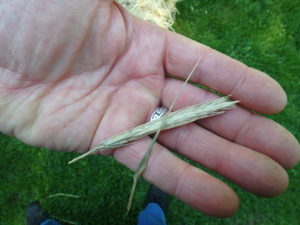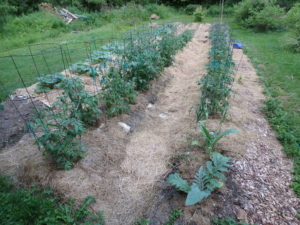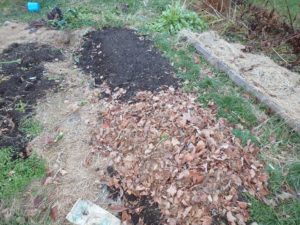Mulching: Hay, Straw and More
If weeds are the bane of the gardener, mulch is the gardener’s friend. Not only that, mulch can hold in moisture in dry times, and give a nice, tidy look to the garden.
Let’s start in the vegetable garden. Properly mulched, weeding can be minimal – say an hour a week for a big garden like mine. I keep down weeds in my walkways and around all large plants like tomatoes with a one-two punch: a layer of newspapers (4 to 6 pages thick) and a layer of straw or mulch hay (4 to 6 inches thick before it packs down).
What is the difference between mulch hay and straw? Price, for starters. You can easily pay $8 to $10 a bale for straw, and as little as $2 or $3 for hay. Why is that? Straw is grown as a crop specifically sold as mulch, and it has no seeds. You might see what appear to be seed heads, but they are empty as the farmer grows rye, then cuts it before pollination takes place.
Hay is a waste product: food for dairy cows that got rained on, and is no longer edible. Picky eaters, those dairy cows. And it has plenty of seeds. The newspapers I put beneath it generally keep hay seeds from growing in the garden. But some seeds will escape and grow – particularly in the spring of year two unless you did a phenomenal job of cleaning up in the fall.
Many gardeners use black landscape fabric in the flower garden, covered with bark mulch or wood chips. The fabric is a good barrier, though the roots of some weeds and grasses can get through it, making it difficult to remove. Other gardeners use bark mulch directly on the soil, and that can be effective, too.
If you use wood chips or bark mulch, be sure not to place too thick a layer down. Two to three inches is good, 4 to 6 inches is bad – the mulch will keep a quick rain shower from getting moisture to the roots of your plants.
Some gardeners worry about bark mulch stealing nitrogen from the soil as it breaks down. Don’t. Yes, the microorganisms that break down the mulch need some nitrogen, but I have never seen plant leaves turn yellow (the sign of nitrogen deficiency) because of mulch. Or if you must worry, just put a layer of slow-release organic fertilizer on the soil beneath the mulch.
You can buy wood chips or ground bark mulch in bags or by the truckload. Buying it by the bag is convenient if you just need a little, but it is much more expensive that way.
If buying wood chips by the bag, read the label. If it says, ‘color enhanced’, I would avoid it. It means the chips have been dyed – and I am an organic gardener who does not want chemicals. I have heard that some cheap wood chips are actually construction waste that has been chipped and dyed – old 2-by-4’s and the like.
I like ground hemlock because of the color, and the fact that it tends to last longer than some others (except cedar, but I have only found that for sale in bags). I buy the hemlock by the pick-up truck load.
And please, for the health of your trees, do not create “mulch volcanos.” To keep down weeds some gardeners pile wood chips right up against the trunks of trees in a volcano shape. The wood chips may harbor fungi and bacteria that can attack the bark of your precious tree, eventually killing it in 6 to 10 years. Instead of a volcano, create a “donut.” Leave 3 or 4 inches of space between the tree and the mulch.
My favorite mulch? Fall leaves that have been run over by a lawn mower, then raked and stored for the spring. Full of goodness for the soil, and a good deterrent to weeds. Over the years, leaves will enrich your soil considerably. And they’re free!
Cocoa mulch is sold as a mulch, and I know some who love it. It has a very fine texture and looks nice. But it smells like chocolate chip cookies when it first goes down, and some dogs have been known to consume it – causing sickness and even death if one believes everything one reads on the internet. Chocolate products are bad for dogs. It also tends to mold, though that only lasts a week or so. It can be very slippery when wet; I advise against using it on a hillside.
Buckwheat hulls are an alternative to cocoa mulch, but they are not sold in many garden centers. Like cocoa hulls, they are very fine textured and look very nice, but are very expensive compared to bark or wood chips.
At the Chelsea Flower Show, which I attended recently in London, someone had quotes about gardening stenciled onto blank walls. One of my favorites was from Robert M. Pyle: “But make no mistake: the weeds will win. Nature bats last.” So mulch, but don’t expect to get a summer of weed-free gardening.
Read Henry’s blog at https://dailyuv.com/





